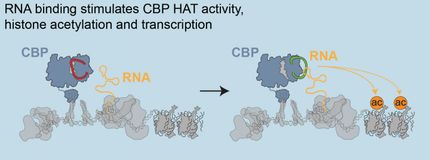A protein complex for the long haul
A multiprotein complex called TREX plays a key role in expression of the genetic information. Moreover, as a new study demonstrates – the longer the gene, the greater the need for TREX function.
In higher organisms, the genetic information, written in the nucleotide sequences of the hereditary material DNA, is stored in the cell’s nucleus. The selective conversion of this information into the set of proteins required to carry out the biochemical functions of each cell is a highly complex, multistep process. First, the DNA sequence that specifies the structure and function of each protein is transcribed into molecules of messenger RNA (mRNA) by the enzyme RNA polymerase II (RNAPII), a process called transcription. These transcripts undergo various modifications before being exported from the nucleus to the surrounding cytoplasm. A protein complex named TREX functions in transcription and mRNA export and couples these two processes. In doing so, it interacts with the transcription machinery and recruits mRNA exporter proteins to the mRNA that transport the mRNAs to the cytoplasm.
“That TREX is recruited to the DNA has been known for a long time. But how the complex gets there has been unclear,” says Katja Strässer, a biochemist at LMU’s Gene Center. The function of the TREX complex is one focus of Strässer’s research, who was already involved in the original discovery of the TREX complex. In their latest study, Strässer and colleagues set out to identify the sites to which TREX binds in the genome of baker’s yeast (Saccharomyces cerevisiae). The team soon noted that the amount of TREX bound increased with the length of the gene. “And that suggested to us how TREX might be recruited to active genes,” says Dominik Meinel, first author of the new paper.
Further experiments showed that TREX binds directly to RNAPII, specifically to the so-called C-terminal domain (CTD) of its largest subunit. This segment of RNAP II is known to act as a binding surface for a range of proteins are be recruited to the site of transcription to “work” on the mRNA. However, to their surprise, the LMU researchers found that TREX is recruited to the CTD by a previously unknown mechanism. “As transcription proceeds, more and more TREX interacts with the CTD – in other words, the longer the gene, the more TREX is attached to RNAPII. The increase in bound TREX with the length of the growing transcript turns out to be important for an adequate amount of long transcripts,” Strässer explains.
This implies that TREX is important for the correct expression of the genome. By binding simultaneously to both RNAPII and the growing RNA, the complex presumably helps the cell to keep long mRNAs in the vicinity of the CTD – to which proteins involved in the processing of nascent transcripts also bind. “This finding adds a new facet to our understanding of how the many steps from mRNA synthesis to the export of the mature mRNA are coordinated. These functional links probably help ensure that only correctly transcribed and processed mRNAs are used for protein synthesis. We now want to investigate whether TREX functions as a gatekeeper in this context,” Strässer says.
Original publication
Other news from the department science

Get the life science industry in your inbox
By submitting this form you agree that LUMITOS AG will send you the newsletter(s) selected above by email. Your data will not be passed on to third parties. Your data will be stored and processed in accordance with our data protection regulations. LUMITOS may contact you by email for the purpose of advertising or market and opinion surveys. You can revoke your consent at any time without giving reasons to LUMITOS AG, Ernst-Augustin-Str. 2, 12489 Berlin, Germany or by e-mail at revoke@lumitos.com with effect for the future. In addition, each email contains a link to unsubscribe from the corresponding newsletter.




















































